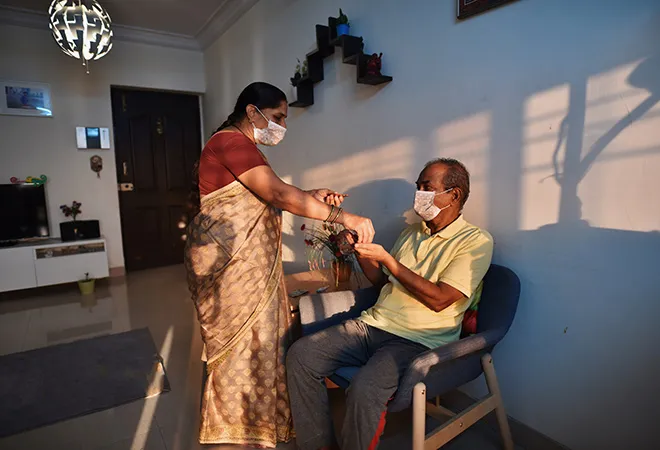
In India, non-communicable diseases (NCDs)—diseases not caused by an infectious agent, but those that are chronic and caused by a combination of genetic, physiological, environmental, and behavioral factors—account for nearly 63 percent (5.87 million) of the country’s total annual mortality. Most of these deaths are premature (age 30–70) and occur during the most productive years of life. Four main NCDs are cardiovascular diseases, chronic respiratory disease, cancer, and diabetes. India has 257 million people with hypertension and 77 million people with diabetes—accounting for 2 million annual cardiovascular disease-related deaths. One in eleven adults in India (age 20-79) has been diagnosed with diabetes (and 43.9 million are estimated to be undiagnosed). The Ministry of Health is already implementing a National Programme for Prevention and Control of Cancer, Diabetes and Cardiovascular Disease and Stroke. The Programme aims to raise awareness, set up infrastructure, and carry out screenings at the primary health care level. India adopted ten national NCD targets in 2013 and thereafter, released the National Multi-Sectoral Action Plan for Prevention and Control of Common NCDs (2017-22). The integration of NCD priorities within the development agenda was recognized with the adoption of the Sustainable Development Goals in 2015.
The COVID-19 and NCD burden in India
India’s burden of NCDs poses a huge challenge in responding to COVID-19. Existing evidence suggests that People Living with Non-Communicable Diseases (PLWNCDs) are at greater risk of becoming severely ill or dying from COVID-19. Many countries reporting high fatality have stated that deaths are higher among the elderly and those with co-morbidities (one or more medical conditions) such as diabetes, hypertension, and heart disease co-occurring with COVID-19. As of June 28, 2020, India has a total of 544,615 COVID-19 cases and more than 70 percent of these cases are due to co-morbidities. Even during the pre-COVID-19 phase, many PLWNCDs remained undiagnosed due to a lack of awareness or insufficient health care access. The increasing burden of COVID-19 has exacerbated the vulnerability of PLWNCDs, as those with established NCDs mostly have inadequately controlled diseases. As the country develops guidelines to end several lockdowns, the situation for PLWNCDs may not improve unless innovative solutions are found to identify and protect them.
COVID-19 complications and NCDs
Cardiovascular diseases (CVDs) are the number one cause of death globally, causing 17.9 million deaths each year. Global data highlights that cardiovascular risk factors—often hypertension, followed by diabetes—are highly prevalent in patients hospitalized with COVID-19. Cancer patients with pre-existing co-morbidities like CVD or diabetes, when infected with COVID-19, can have serious, potentially fatal infections. Similarly, the risk of death is 50 percent higher among infected people with diabetes, and their recovery periods are often prolonged.
Challenges due to disrupted health services
During the lockdown, PLWNCDs around the world have faced innumerable challenges in managing their conditions. Overburdened health systems were reorganized and PLWNCDs were not a priority. There have been reported disruptions in chronic care, blockages in supplies of essential medicines and technologies, screenings, and diagnoses, as well as limited access to health workers and support services critical to the management of NCDs. Recently, WHO conducted a rapid assessment survey of service delivery for NCDs among 194 countries to determine disruptions in NCD services during the pandemic. Of the 155 countries that responded, 77 percent reported disruptions in service. India reported that 30 percent fewer cardiac emergencies reached health facilities in rural areas in March 2020 compared to the previous year.
Health care services
During India’s lockdown, health care services in India were disrupted due to the unavailability of the public transportation system, as well as the closure of many health facilities. Few media reports and articles in scientific journals have reported reductions in essential public health and clinical interventions, as reported by health facilities across India on National Health Mission. The data highlighted a reduction in availing medical treatment (including both inpatients and outpatients) and emergencies for both infectious and NCDs.
In urban settings, there were disruptions in routine in-person outpatient care as these services shifted to telemedicine and only registered patients could be attended to for follow up visits. This has limited the ability to diagnose new NCD patients and manage their conditions. Telemedicine practice guidelines were approved by the Government of India on March 25, 2020 that enabled and regulated registered medical practitioners to provide health care using telemedicine during challenging times such as the COVID-19 pandemic.
Protecting vulnerable NCD patients
While COVID-19 cases in India continue to climb, the recovery rate in India is at 58.56 percent as of June 28. In mid-April, Kerala had a fatality rate of 0.5 percent, which was among the lowest in the world. It also had an encouraging recovery rate. The reason for these encouraging figures in Kerala was attributed to a drive in health surveillance—vulnerable senior citizens, people with co-morbidities, and underweight and malnourished children were closely monitored and PLWNCDs received one month’s supply of their medication at their doorstep. This was done through multi-sectoral and multi-stakeholder coordination. At the same time, its neighboring state, Karnataka, recorded a fatality rate of 4.3 percent and attributed it to late referrals, ie, co-morbidities and patients not being identified and brought promptly to hospitals.
Increasing risk for future NCDs
Responses to COVID-19, including lockdowns, physical distancing, and self-isolation may increase exposure to some NCD risk factors such as increased alcohol and tobacco use as coping mechanisms, barriers to physical activity, and unhealthy diet. This will pose a new challenge for a currently healthy population being exposed to NCD risk factors, and will face the burden of NCDs later in life. At the onset of the pandemic, WHO even advised people to remain healthy and improve their immunity by taking measures such as quitting tobacco use. In India, smokeless tobacco use is a prominent form of tobacco use—21 percent compared to 11 percent of smokers. In April 2020, the Indian Council of Medical Research appealed to the public to refrain from consuming smokeless tobacco products and spitting in public places during the pandemic. The Government subsequently banned the sale of all smoking and smokeless tobacco products under the National Directive for COVID-19 Management.
International agencies are now appealing to governments to ensure that NCDs prevention and treatment are included in national preparedness plans, beginning with the inclusion of NCDs in national COVID-19 responses as part of global health security. Identifying PLWNCDs, providing them with health system support through telemedicine, digital interventions to manage their NCDs, and helping them prevent risk factors by quitting tobacco and alcohol are some immediate steps to protect them from the current crisis. As we all prepare to live with COVID-19 for the next few years, we need to constantly make efforts to protect vulnerable PLWNCDs and keep prioritizing their needs. The need of the hour is to develop strong health care systems, a resilient, qualified, well-resourced health workforce, and healthy populations.
This essay originally appeared in India in Transition, a publication of the Center for the Advanced Study of India, University of Pennsylvania
The views expressed above belong to the author(s). ORF research and analyses now available on Telegram! Click here to access our curated content — blogs, longforms and interviews.




 PREV
PREV


